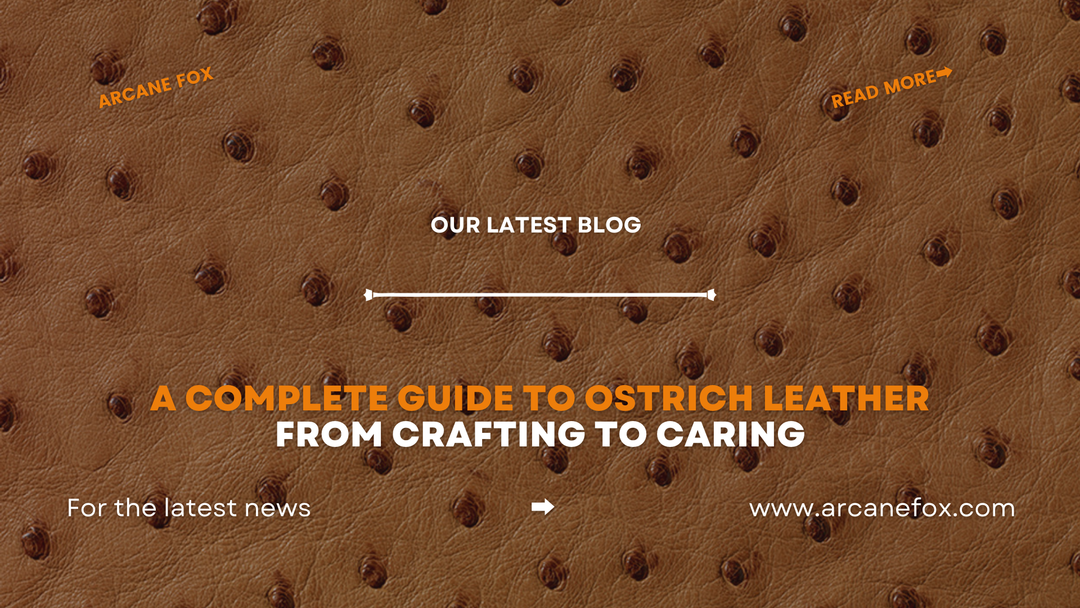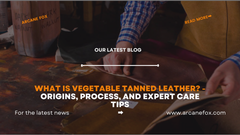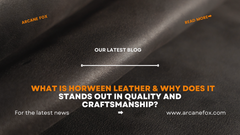A Complete Guide to Ostrich Leather From Crafting to Caring

A Complete Guide to Ostrich Leather From Crafting to Caring
When it comes to luxury, few materials can turn heads quite like ostrich leather. With its signature quill pattern, it has a charm and texture that stands out.
In a world of sleek, often uniform materials, ostrich leather remains unique. But what exactly makes it so special? And how does it become the bags, shoes, and accessories we admire?
In this guide, we’ll explore the world of ostrich leather—taking you through its unique crafting process, the types that exist, and even tricks to keep it looking its best.
Whether you’re already a fan of this exotic leather or just curious, this is your full-access pass to all things ostrich. There’s so much to discover!
So, let’s dive in and see why ostrich leather is more than just a pretty texture; it’s a lasting statement in luxury.
1. What is Ostrich Leather?

Ostrich leather is a luxurious, exotic material known for its unique texture. Unlike other leather types, it features a distinctive pattern of raised quill marks.
These small, bumpy quills come from the feathers, giving the leather its signature look and feel. This texture isn’t just for show—it’s a result of the natural structure of the ostrich skin.
Originally, ostrich leather was used mainly for functional items, but its appeal quickly turned it into a sought-after luxury. Today, it’s a top choice for high-end fashion and accessories.
The leather is soft, durable, and incredibly flexible, which makes it ideal for crafting unique pieces. From bags to shoes, ostrich leather items offer something different.
Its combination of durability and beauty is what makes ostrich leather so popular. Few materials have this blend of functionality and high-end appeal.
2. The History of Ostrich Leather

Ostrich leather's story begins in South Africa in the 1850s. Originally, ostriches were farmed for their feathers, which were popular in high fashion at the time.
By the early 1900s, the demand shifted from feathers to leather. People began noticing ostrich leather’s durability and unique appearance, sparking interest beyond practical uses.
In the 1970s, ostrich leather took off globally, especially in the luxury market. Cowboy boots and high-end accessories featuring ostrich leather became status symbols.
Today, South Africa and North America lead ostrich leather production, supplying the fashion industry with this rare material. Its reputation as a premium leather remains strong. Moreover, the journey from functional hide to luxury staple has made ostrich leather a fascinating part of fashion history, with its appeal only growing over time.
3. Types of Ostrich Leather
Ostrich leather comes in several distinct types, each offering a unique look and feel. These variations in texture and pattern make ostrich leather highly versatile for different styles.
3.1 Full Quill Ostrich Leather
Full quill ostrich leather is the most recognizable and valuable type. It features raised bumps, or “quills,” giving it a signature textured pattern that’s hard to miss. Moreover, This type is typically used for luxury items, like handbags, shoes, and accessories, where the bold pattern can really shine. Its texture makes it a top choice for those looking to make a fashion statement.

3.2 Partial Quill Ostrich Leather
Partial quill ostrich leather, as the name suggests, has fewer quills than the full quill version. The quills are less prominent, creating a more subtle texture while still showcasing ostrich leather’s uniqueness. This type is often preferred for items that need a more refined appearance, offering the elegance of ostrich leather without the boldness of full quill.

3.3 Smooth Ostrich Leather
Smooth ostrich leather has little to no quill markings, making it appear more like traditional leathers. It’s often used in smaller, detailed items, such as wallets and belts, where a sleek, minimalist look is desirable. Though it lacks the characteristic bumps, smooth ostrich leather still retains the softness and durability that make ostrich leather special.

3.4 Embossed Ostrich Leather
Embossed ostrich leather is created by imprinting quill-like textures onto leather that isn’t originally quilled. This type offers the appearance of full quill ostrich leather at a lower cost. While it doesn’t have the same authenticity, embossed ostrich is an accessible option for those who want the look without the premium price tag.

Each type of ostrich leather provides something unique, whether it’s the boldness of full quill, the subtlety of partial quill, or the accessibility of embossed leather. Together, they make ostrich leather adaptable to any style or need.
4. How Ostrich Leather is Made?



Creating ostrich leather begins with carefully sourcing the hide after the animal has been used for meat and feathers. Notably, researchers at Stellenbosch University in South Africa studied how various factors, like age and lifestyle, significantly affect the final quality of ostrich leather.
The results? Indeed, age and processing methods play the biggest roles in quality. Once harvested, the skin then goes through a thorough cleaning and prepping phase to prepare it for tanning. This early stage, known as the raw leather phase, is essential for achieving high-quality results.
Typically, ostrich leather undergoes chromium tanning, as vegetable tanning would be too harsh for its delicate fibers. The chromium process leaves the leather in a “crust” state, which allows for custom colors and finishes to be added. To achieve the desired color and texture, the leather is dyed in a drum and, in some cases, finished with a protective topcoat. This final step creates the smooth and luxurious leather seen in high-end products.
4.1 Production Statistics of Ostrich Leather
- Volume per Year – Annually, more than 600,000 ostrich skins are produced. Ostrich leather remains a popular choice among exotic leathers, sustaining high production levels.
- Key country or countries where it is produced – South Africa is the largest ostrich leather producer, responsible for nearly half of the global supply, producing over 250,000 hides each year. Australia, China, and Israel are also significant producers. Vanessa Barends-Jones from the Western Cape Government, Agriculture, noted that South Africa’s smaller regions with ostrich farms and tanneries contribute greatly to regional economies.
- Biggest exporting countries – South Africa is the leading exporter of ostrich leather, with most hides sourced from local farms. Australia and China are also prominent sources for this leather.
- Biggest importing countries – The largest importers of ostrich leather are India, China, and South Korea. These countries have established tanning facilities to dye and finish the imported leather.


4.2 Cost of Ostrich Leather
- Square Foot – Ostrich leather is rarely sold by the square foot, but prices range from $18–$40 per square foot, depending on the leather grade.
- Half Hide – A ½ hide of ostrich leather typically costs between $100–$400. The price can vary greatly based on the cut, as the crown area is most valuable.
- Full Hide – The cost for a full ostrich hide ranges from $200–$600, influenced by the leather’s size and quality grade.
- Ostrich Leg – Ostrich legs are usually sold separately from hides. These smaller pieces, under 1 square foot, generally cost between $10–$50.

4.3 Ostrich Leather Pricing Breakdown
Ostrich leather prices vary by grade and quality.
1. Grade A, nearly flawless leather, costs $30–$40 per square foot, $200–$300 for a half hide, and $400–$600 for a full hide.
2. Grade B has minor blemishes on the crown, priced at $25–$30 per square foot, $175–$200 for a half hide, and $250–$400 for a full hide.
3. Grade C, with more crown blemishes, costs $22–$25 per square foot, $100–$175 for a half hide, and $200–$250 for a full hide.
4. Grade D features an A4-sized blemish-free area, priced at $20–$22 per square foot, $90–$100 for a half hide, and $175–$200 for a full hide.
Lastly, Grade E has an A5-sized blemish-free area and costs $18–$20 per square foot, $75–$90 for a half hide, and $150–$175 for a full hide.

4.4 Tips for Working With Ostrich Leather
- Lightly press down the quill bumps to create a smoother surface.
- Carefully control thread tension when sewing to prevent distortion.
- Reinforce the leather for added rigidity in finished products.
- Use a sharp blade to minimize stretching during cuts.

5. Unique Characteristics of Ostrich Leather
5.1 Surface Texture
Ostrich leather’s bumpy surface, created by quill follicles, is its most defining feature. These quill bumps, concentrated on the crown of the hide, give the leather its unique, luxurious appearance. The bumps can be flattened for a smoother look if desired, but many prefer the natural, textured finish. The sides and other areas of the hide lack these bumps, offering a more subtle texture.
5.2 Flexibility
Ostrich leather is incredibly flexible, making it ideal for items like bags and wallets that need to bend without breaking. Unlike stiffer leathers, ostrich leather remains resilient and won’t crack or crease easily. This flexibility is a key reason why it’s valued for high-end accessories that benefit from both durability and style.

5.3 Softness
Despite the bumpy texture, ostrich leather is soft to the touch, providing a luxurious feel. This softness, combined with its flexibility, makes ostrich leather pleasant to handle. While the main body is typically very soft, areas like the neck or legs may feel firmer due to natural variations in the hide’s thickness.
5.4 Sewability
Working with ostrich leather can be challenging due to its stretchy nature. It’s very supple, so during sewing, the material may bunch if not handled with care. Skilled artisans manage thread tension closely to create a smooth, finished look. Reinforcing the leather can also help improve stability without compromising its natural beauty.
Read More: How Does Soft Leather Stand Out from Other Types of Leather?
5.5 Durability
Ostrich leather is known for its durability, which comes from the natural oils in the hide. These oils help prevent the leather from drying out or cracking, even with extended use. Unlike some other leathers, ostrich leather holds up well under sunlight and frequent handling, making it a long-lasting choice for luxury products.

5.6 Ease of Maintenance
Caring for ostrich leather is relatively straightforward. Despite its exotic reputation, it requires basic maintenance similar to cowhide leather. Regular conditioning and gentle cleaning with appropriate leather products will keep it in good shape. Thanks to its natural oils, ostrich leather often stays hydrated longer, reducing the need for frequent conditioning.
5.7 Colors
One of ostrich leather’s unique advantages is its wide range of available colors. The leather undergoes chromium tanning, which allows it to be dyed in almost any shade, from classic neutrals to vibrant, bold colors. Moreover, This versatility in color options makes ostrich leather suitable for a variety of fashion styles.
5.8 Waterproofness
While durable, ostrich leather is not fully waterproof. Small water droplets may bead up, but larger amounts or prolonged exposure can darken the leather. For items exposed to water regularly, a water-resistant treatment is recommended to protect the material from damage.
5.9 Cost
The crown of ostrich leather, with its distinctive quill bumps, is the most valuable part, costing $200–$600 per hide, depending on grade and size. Lower-grade leather may show imperfections or uneven dye. Ostrich leg leather, a smaller and more affordable option, features a unique scaled pattern instead of bumps and typically costs $10–$50 per piece.

6. Pros and Cons of Ostrich Leather

6.1 Pros of Ostrich Leather
One of the biggest appeals of ostrich leather is its unique texture, created by the distinctive quill bumps. This feature gives ostrich leather a luxurious, eye-catching look that stands out.
Beyond its visual appeal, ostrich leather is soft, flexible, and highly durable. It’s ideal for items that endure frequent use, like bags, wallets, watch straps, and boots.
Thanks to its natural oils, ostrich leather stays hydrated for longer, minimizing the risk of dryness or cracking. This durability, combined with easy maintenance, makes it a popular choice for high-end accessories.
6.2 Cons of Ostrich Leather
While ostrich leather has many benefits, it does come with challenges. It’s one of the pricier exotic leathers, which makes it a significant investment.
The uneven surface from the quill bumps can make crafting difficult. The leather’s slight stretchiness can make cutting straight lines tricky and precise.
Sewing can also be challenging, as the flexibility may cause bunching during stitching. Proper thread tension, especially for hand sewing, is essential, requiring more attention than with other leathers.
7. Examples of Items Made from Ostrich Leather

Ostrich leather appears in a variety of products, including wallets, watch straps, shoes, bags, and boots. Cowboy boots, known for their bold style, helped popularize ostrich leather by using it as an accent, giving the boots a unique, luxurious touch.
Handbags are another popular item made from ostrich leather. Thanks to its natural flexibility, ostrich leather works beautifully for larger items that require curves and bends, allowing designers to create intricate shapes without worrying about wrinkles or cracks.
Popular Uses for Ostrich Leather:
- Wallets
- Bags
- Boots
- Shoes
- Cigar Cases
- Watch Straps
These items showcase ostrich leather’s versatility, durability, and unique aesthetic appeal, making it a preferred choice for high-end accessories.
8. Our Research While Using Ostrich Leather
As leather crafters, we prioritize both beauty and function in our projects. Ostrich leather quickly impressed us with its unique look, but hands-on experience revealed some challenges. We tested cutting, edge finishing, and sewing to evaluate its performance.
On receiving the leather, we pressed down bumps in our work area to create a smoother surface. Cutting required holding the leather firmly, as it stretched under the blade, and we relied on our sharpest knife to avoid multiple passes.
For punching and sewing, flattening the surface helped keep punch lines consistent. Sewing, however, was tricky; tightening stitches sometimes caused the leather to ripple, so careful, slow adjustments were necessary.
Finishing the edges proved challenging as well. The bumps made beveling difficult, leading us to use edge paint instead. While edge paint provided a cleaner look, the bumps still caused slight unevenness along the edges.
9. Ostrich Leather Care and Maintenance

9.1 How to Clean Ostrich Leather?
- Use a horsehair brush or soft, damp cloth for regular dusting.
- For deeper cleaning, apply leather soap sparingly; it may darken the leather.
- Avoid large amounts of water, as ostrich leather is not waterproof and can darken if left untreated.
9.2 How to Condition Ostrich Leather?
- Natural oils help keep ostrich leather hydrated, but occasional conditioning is beneficial.
- Apply leather conditioner with a soft cloth in small amounts to prevent oversaturation.
9.3 How to Store Ostrich Leather?
- Store away from direct sunlight and heat, as it’s still sensitive to these elements.
- Use a soft, breathable bag to protect the leather from scratches and marks.
10. Conclusion
Ostrich leather is a remarkable material, combining luxury, durability, and a one-of-a-kind texture. From its unique quill bumps to its soft, flexible feel, ostrich leather brings both beauty and resilience to high-end products. Though it requires skilled handling and careful maintenance, its lasting appeal and quality make it worth the investment.
Whether used in handbags, wallets, or boots, ostrich leather remains a top choice for those who appreciate style and substance. With the right care, your ostrich leather items can last for years, maintaining their elegance and charm. This exotic leather truly stands out as a timeless, luxurious addition to any collection.
Related Posts:
- Leather 101 - The Ultimate Guide to Different Types of Leather
- How is Leather Made? A Step-by-Step Guide of the Leather Tanning Process
- What is Vegetable Tanned Leather? - It's Origins, Process, and Expert Care Tips
- What is Chrome-Tanned Leather? - Its History, Process, and More
- What is full-grain leather? Everything You Need to Know
- What is Top Grain Leather? The Comprehensive Guide
- What is Cowhide Leather? Origins, Types, and Maintenance
- What is Goatskin Leather? Different Types of Goatskin, Quality, Durability and More
- What is Exotic Leather? Origins, Types, Care, and more
- What is Calfskin Leather? It's Quality & Durability Against Other Leather!
- What is Embroidery Leather? & What to Look for In Leather Embroidery?
- What is Pig Leather? & Why it is a Strong and Versatile Choice for Your Projects





